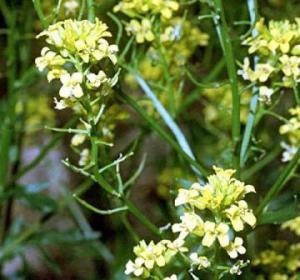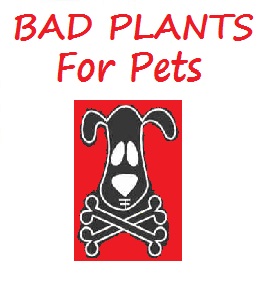Yellowrocket

Barbarea is a genus of about 22 species of flowering plants in the mustard family (brassicaceae). Depending upon the specific plant species they are known by a variety of names to include: bittercress, common cress, indian posey, land cress, St. Barbarba herb, scurvy cress, upland cress, yellow rocket and watercress. These plants are native to North America, including much of Canada and the western United States, as well as parts of Asia. They are considered perennial herbs, and typically produce a stiff, branching stem. The leaves are a few centimeters long and generally oval in shape with several rounded lobes toward the end. The inflorescence is a spike or cluster of bright yellow flowers at the tip of each stem branch. The fruit is a straight, narrow silique up to 5 centimeters long.
Plants in the family should be considered toxic as (like many plants) they produce chemical compounds to defend themselves against being eaten. In this case, the plants produce glucosinolates and the enzyme myrosinase. Individually these two compounds pose no threat and are stored in separate compartments within the plant. However, when the plant is subjected to mechanical damage as would occur when the leaves, stems etc. are torn or chewed, the two compounds combine. The glucosinolates are then converted by the myrosinase enzyme into substances such as isothiocyanates, thiocyanates, nitriles and goitrin. While typically not serious these substances can cause mild to severe digestive tract irritation depending upon the amount of the plant that was ingested; small amounts are rarely a problem. The Canadian Biodiversity Information Facility, which contains a large database of information on poisonous plants and past poisoning cases states that a horse was poisoned “in one unusual case in which the animal ate large quantities of the plant from a wagon that was hauling the weed from a field (Hansen 1930). The symptoms suggested gluocosinolate poisoning, as in Brassica spp.” Perhaps more dangerous than the actual chemicals the plant produces is the fact that these plants readily absorb, accumulate, and store environmental toxins, such as pesticides and nitrates. Toxins which are then passed onto the animal that chooses to ingest the plant.
The overall threat to livestock posed by these plants is low, as most animals find them to be relatively unpalatable. As a result they will typically ignore them unless other food sources are limited. Due to the weedy nature many plants of this genus possess they can, however, infest pastures, choking out other non toxic plants; essentially forcing themselves on grazing animals and thus becoming the bulk of their diet. Poisonings occur most commonly as the result of contaminated hay.
Avoid further ingestion of the plant and consult a veterinarian. Life threatening intoxication is exceedingly rare, fatalities, while theoretically possible are basically unheard of. Due to the limited amount that animals are likely to consume, serious intoxication is rare and in most cases ingestion will only result in mild to moderate gastrointestinal disturbance. In regards to a specific treatment regimen, common sense symptomatic care will probably be all that is required. If the ingestion was recent remove any existing plant matter from the mouth and flush thoroughly with water. If vomiting does not occur it may be induced by giving and emetic such as 3% hydrogen peroxide orally at a dose rate of 1 teaspoon per 10 lbs of body weight. The pet (dogs and cats) will more than likely start vomiting spontaneously without the help of an emetic, as their body tries to expel this non digestible material. The universal antidote, activated medical charcoal may also prove to be of some use in absorbing the toxins.
Ensure the pet gets plenty of fluids to avoid possible dehydration caused by diarrhea. To alleviate the gastrointestinal upset and diarrhea; Kapectolin may be given at a dose rate of 1 to 2 ml/kg four times a day. Kapectolin provides a coating action that protects the stomach lining. Sucralfate may also be used as for gastrointestinal irritation as it reacts with the acids in the stomach to form a paste-like material capable of acting as a barrier between the stomach and its contents. Sucralfate is typically given to dogs weighing more the 60lbs: 1g every 6 to 8 hours; for dogs under 60 lbs: 0.5g every 6 to 8 hours; Cats: 0.25g every 8 to 12 hours to reduce irritation of the stomach and intestines. The prognosis is generally excellent, provided the animal is not suffering the ill effects of environmental toxins that were stored in the plant. With symptomatic care most animals will make a full recovery in a few hours to a few days.




